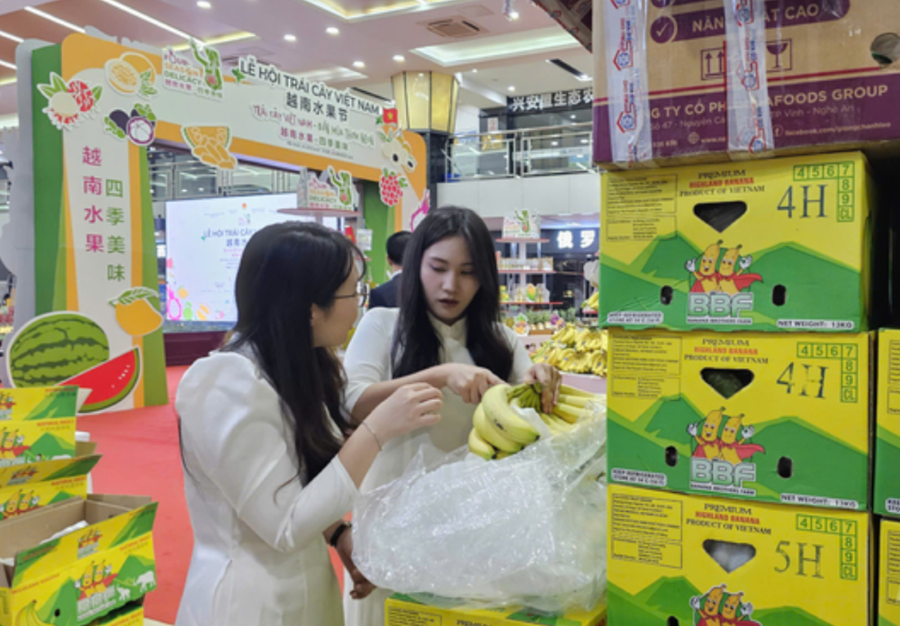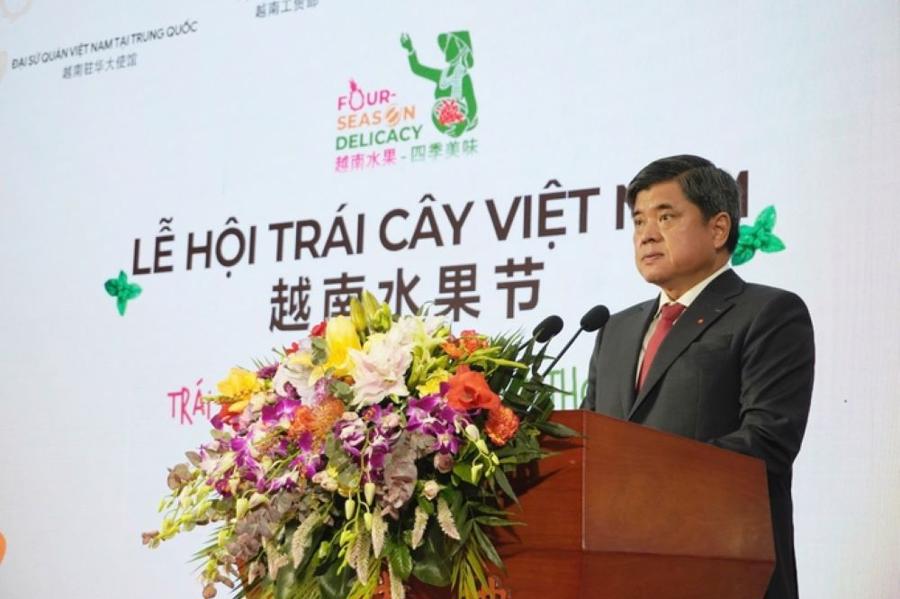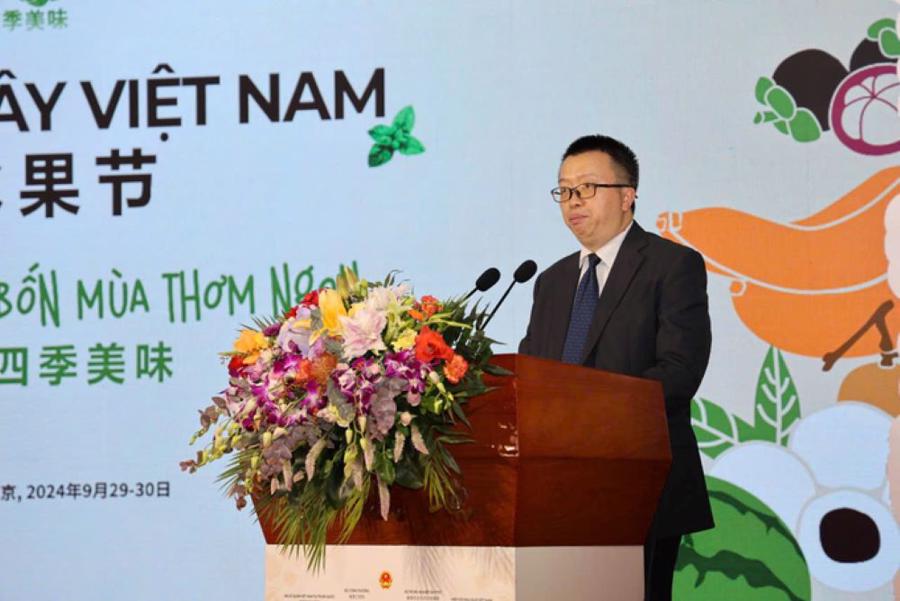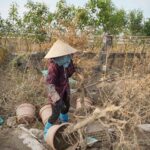The first Vietnam Fruit Festival, themed “Vietnamese Fruits – Four Seasons of Deliciousness,” was a two-day event held on September 29-30 at the Tan Phat Dia Agricultural Distribution Center in Phong Dai district, Beijing, China. It celebrated the successful state visit of Vietnam’s General Secretary and President To Lam to China and his high-level meeting with Chinese President and General Secretary Xi Jinping.
The fruit festival was organized by Vietnam’s Ministry of Agriculture, in collaboration with the Vietnamese Embassy in China and the Vietnam Fruit and Vegetable Association, coinciding with the 13th meeting of the Vietnam-China Economic and Trade Cooperation Committee.
VIETNAM AIMS TO EXPORT FRUIT TO CHINA WORTH 4.5 BILLION USD BY 2024
In his opening remarks at the fruit festival, the Deputy Minister of Vietnam’s Ministry of Agriculture and Rural Development highlighted that this was the first fruit festival held, offering a valuable opportunity for businesses and consumers from both countries to enjoy delicious and pure Vietnamese fruits. This event marked an important milestone in the agricultural and agricultural trade cooperation between the two nations. It also provided a unique chance for enterprises from both sides to connect, trade, and promote the development of their respective fruit industries.

Vietnam and China share a close relationship as neighboring countries with a long history of friendship and cultural similarities. Their geographic proximity, similar soil and climate conditions, and shared culinary traditions create a favorable environment for bilateral trade, especially in specialty fruits. By bringing Vietnamese fruits to the Chinese market, consumers can enjoy the wonderful flavors of various fruits as if they were in Vietnam itself, added Deputy Minister Tran Thanh Nam.
“Currently, Vietnam has 5,840 fruit-growing area codes granted by importing countries, of which 2,350 area codes, or 40.2%, are for exports to the Chinese market.”
Mr. Tran Thanh Nam, Deputy Minister of Vietnam’s Ministry of Agriculture and Rural Development.
According to Deputy Minister Nam, in recent years, with the strong support of the General Administration of Customs of China and related agencies, along with the dedication of the Ministry of Agriculture and Rural Development and the Ministry of Industry and Trade of Vietnam in planning growing areas, ensuring transparency in the cultivation process, and strictly managing the granting and administration of growing area codes, packaging facilities, and traceability systems…
As of now, 12 types of Vietnamese fruits are exported to the Chinese market, with an estimated value of 4.5 billion USD in 2024.
Vietnam, a tropical country with a territory spanning 15 degrees of latitude, boasts ideal conditions for growing a variety of fruits with distinct flavors, including dragon fruit (annual output of 1.3 million tons), mango (1.1 million tons), durian (1.2 million tons), banana (2.5 million tons), grapefruit (1.1 million tons), jackfruit (980,000 tons), lychee (320,000 tons), longan (635,000 tons), pineapple (725,000 tons), rambutan (320,000 tons), avocado, and passion fruit. These products are grown in areas with granted growing area codes, meeting national and international quality standards for export.

“Vietnamese fruits are not just a wonderful gift from nature but also ambassadors of Vietnamese agriculture, embodying the cultural essence of Vietnam,” emphasized Deputy Minister Tran Thanh Nam.
To further promote agricultural trade between the two countries, Deputy Minister Nam expressed his hope that relevant agencies from both sides would continue to collaborate and remove barriers to opening up the agricultural market, especially with the support of the General Administration of Customs of China. He also encouraged the expansion of trade in agricultural, forestry, and aquatic products, particularly specialty fruits from Vietnam, in the Chinese market.
Associations, businesses, and investors from both countries should strengthen cooperation and linkages to expand markets and develop sustainable agricultural value chains for export. Additionally, there should be increased investment in areas serving exports, such as trade promotion, logistics, wholesale markets, cold chain storage, processing, and breeding. Trade and agricultural authorities of the two countries need to coordinate with local governments, associations, and businesses to organize similar festivals in other potential regions of China in the future.
ECONOMIC AND TRADE RELATIONS AS THE MAIN DRIVING FORCE FOR VIETNAM-CHINA RELATIONS
Representing the Chinese side, Mr. Li Yan, Deputy Director-General of the Asia Department of the Ministry of Commerce of China, spoke about the close ties between Vietnam and China, sharing borders, mountains, and rivers. The two nations are good comrades, partners, neighbors, and friends. Under the strategic guidance of the leaders of the two Parties and states, the Vietnam-China cooperation has yielded fruitful results in various fields.
“Economic and trade cooperation is the main driving force for Vietnam-China relations. Since 2004, China has been Vietnam’s largest trading partner, and since 2016, Vietnam has been China’s largest trading partner in ASEAN,” affirmed Mr. Li Yan.

According to Mr. Li Yan, from January to August 2024, bilateral trade between China and Vietnam reached nearly 170 billion USD, an increase of nearly 20% over the same period last year. Vietnam is a major supplier of imported fruits to China.
Thanks to the joint efforts of both sides, high-quality Vietnamese fruits such as durian, dragon fruit, banana, and mango have entered the market of 1.4 billion people in China. At the same time, Vietnamese food products like coffee and pho are also gaining popularity among Chinese consumers.
With the full implementation of the RCEP Agreement and the continuous upgrading of the China-ASEAN Free Trade Agreement, cooperation between the two countries in technology, standards, and agricultural production is deepening and expanding.
“This is the first time Vietnam has held a fruit promotion event in Beijing. I hope that Vietnamese enterprises will seize this opportunity to actively explore the Chinese market. I also hope that Beijing citizens will seize this rare opportunity to taste delicious Vietnamese fruits and introduce this unique fruit flavor to their friends and family.”
Mr. Li Yan, Deputy Director-General of the Asia Department, Ministry of Commerce of China.
Mr. Truong Ngoc Ty, Chairman of the Board of Directors of the Tan Phat Dia Agricultural Distribution Center, shared that Beijing is an international city with a population of up to 30 million, and the demand for high-quality agricultural products is enormous. The Tan Phat Dia Center is the main supplier of fruits and vegetables for the capital’s residents, providing up to 90% of agricultural products in Beijing. In 2023, the total transaction volume of agricultural products at Tan Phat Dia reached 15.16 million tons, with a total transaction value of 126.7 billion RMB.
“Beijing has a very low self-sufficiency rate for agricultural products, with most of its supply coming from other provinces and imports from abroad. Every year, agricultural products from 46 countries and regions are exhibited at Tan Phat Dia, and it can be said that ‘Just stepping into Tan Phat Dia, you can taste cuisine from all over the world,'” said Mr. Ty.
To enhance quality control and actively promote cooperation in building and sharing the “Belt and Road Initiative,” Tan Phat Dia has expanded its planting bases in Vietnam, Thailand, Laos, Myanmar, Cambodia, the Philippines, and Malaysia. Dragon fruit, banana, mango, watermelon, and purple sweet potato are mainly grown in Vietnam, covering an area of more than 20,000 acres. In the future, Tan Phat Dia will further strengthen cooperation in durian, jackfruit, longan, passion fruit, mangosteen, and other crops in Vietnam.
“The Vietnam Fruit Festival is an important and timely event, reflecting the relentless efforts of the Vietnamese people to meet the needs of the Chinese market. We look forward to seeing more high-quality Vietnamese fruits entering the Chinese market, adding rich variety to the diets of Beijing residents,” the leader of Tan Phat Dia emphasized.
Vietnam Receives the Scepter to Host the 2025 FWC
At the FIATA World Congress (FWC) 2024, which recently took place in Panama City, Panama, the representative from Vietnam, the Vietnam Logistics Services Enterprises Association, proudly accepted the baton to host the FWC 2025 in Hanoi. The prestigious event will be held from October 6-10, 2025, and promises to be a showcase of Vietnam’s logistics industry and its integral role in global trade.
Anxiously Reviving the North’s Largest Bonsai Village
“I have to immediately rehabilitate the land and borrow capital for reproduction. The people of Phung Cong will rise again, and the fields will be green,” said Nguyen Thi Quyen determinedly. However, like many other residents of Phung Cong, Sister Quyen is anxious and worried as the dike has been destroyed for a real estate project, and the floods will inevitably return one day…
Thousands of Vietnamese Customers Receive iPhone 16 Overnight
Apple enthusiasts and eager customers alike gathered at midnight on September 27th as select dealers opened their doors for the highly anticipated iPhone 16 series launch. The excitement was palpable as people queued up to unbox and experience the latest iPhone models as soon as they went on sale.
The Power of Insurance: A Lesson from Katrina for Vietnam’s Resilience Against Storms
In 2005, Hurricane Katrina made landfall in the United States, leaving a trail of devastation in its wake. With wind speeds exceeding 175 km/h, the storm caused immense damage, claiming the lives of over 1,800 people and resulting in economic losses of a staggering $120 billion. The impact of the hurricane was felt across the nation, with insurance companies paying out more than $40 billion to help those affected rebuild their lives and recover their assets. As the chief economist of ADB Vietnam highlighted, the storm’s aftermath led to a significant insurance payout, providing much-needed financial support to those who had lost so much.




















